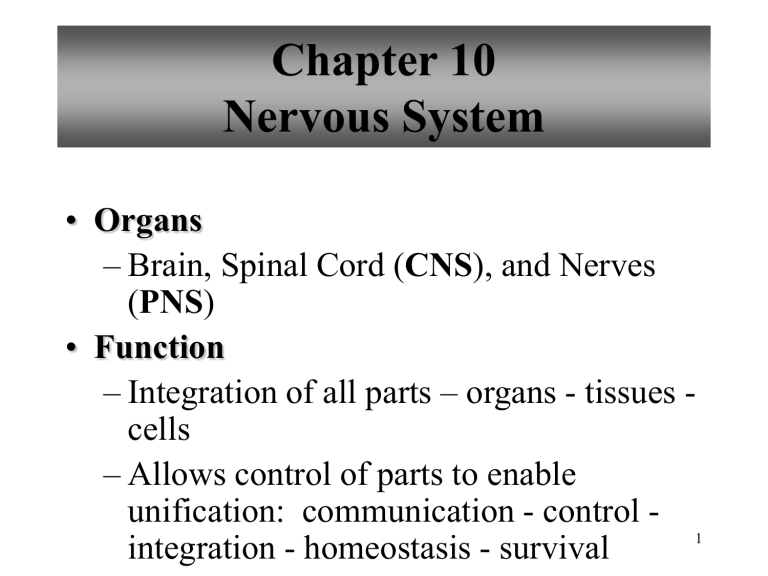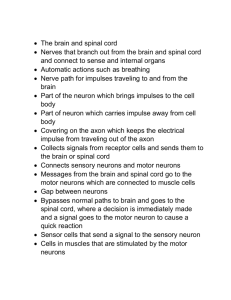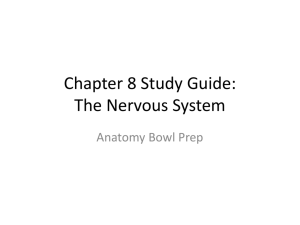Spinal Nerves - Effingham County Schools

Chapter 10
Nervous System
•
Organs
– Brain, Spinal Cord (
CNS ), and Nerves
( PNS )
•
Function
– Integration of all parts – organs - tissues cells
– Allows control of parts to enable unification: communication - control integration - homeostasis - survival 1
Chapter 10
Nervous System
Cell Types of
Neural Tissue
•
Neurons
•
Neuroglial cells
2
Divisions of the
Nervous System
•
Central Nervous System
• brain
• spinal cord
• Peripheral Nervous System
• nerves
• cranial nerves
• spinal nerves
3
Neuron Structure
Soma
4
Neurons
Structure:
• Cell body - Soma
• Axon - sends messages away from soma
• Dendrite - receives messages from axon to soma.
Types of Neurons:
•
Afferent (sensory) - to cord or brain
•
Efferent (motor) - away from cord or brain
•
Interneurons (synapse between 1 and 2) from afferent to efferent (from sensory to motor)
5
Classification of Neurons –
Functional Differences
Sensory Neurons
• afferent
• carry impulse to CNS
Interneurons
• link neurons
• in CNS
Motor Neurons
• carry impulses away from CNS
• carry impulses to effectors 6
Divisions Nervous System
7
Divisions of Peripheral
Nervous System
Sensory Division
• picks up sensory information and delivers it to the CNS
Motor Division
• carries information to muscles and glands
Divisions of the Motor Division
•
Somatic
– carries information to skeletal muscle
• Autonomic – carries information to smooth muscle, cardiac muscle, and glands
8
Functions of Nervous System
Sensory Function
• sensory receptors gather information
• information is carried to the
CNS
Motor Function
• decisions are acted upon
• impulses are carried to effectors
Integrative Function
• sensory information used to create
• sensations
• memory
• thoughts
• decisions
9
Myelination of Axons
White Matter
• contains myelinated axons
Gray Matter
• contains unmyelinated structures
• cell bodies, dendrites
10
Myelination of Axons
• Unmyelinated fibers conduct impulses slower.
• Myelinated fibers conduct impulses faster
– Nodes of Ranvier (short region of exposed axon between Schwann cells on neurons)
– The more myelin the faster the impulse
11
Multiple Sclerosis
• Most common disease of the nervous system
• Loss of myelin sheath
• Hard plaque lesions replace myelin
• Nerve conduction is impaired and weakened, loss of coordination, visual impairment and speech disturbances.
• Most common in women between age 20-40
• No known cure
12
Reflex Arc
13
Reflex Arc
• Conduction of an impulse to and from the brain and spinal cord.
–
Types :
•
Two neuron arc simplest form
– Consists of afferent and efferent neurons
•
Three neuron arc must common
– Consists of afferent, interneurons, and efferent
14
Two Neuron Arc
15
Three Neuron Arc
16
The Synapse
•
Nerve impulses pass from neuron to neuron at synapses
• Under normal circumstances, the movement of the electrical impulse down the length of a nerve is very fast, on the order of 115–197 ft/sec (35–60 m/sec).
17
Synaptic Transmission
Neurotransmitters are released when impulse reaches synaptic knob
18
Brain and Cord Coverings
• Bone is outer cover
– Brain - Cranium
– Spinal cord - Vertebrae
• Meninges - inner cover
– Dura Mater - outer, white fibrous tissue
– Arachnoid Membrane - cobwebby, middle
– Pia Mater - adheres to brain, transparent
•
Meningitis is inflammation of meninges 19
Meninges
20
Meninges
21
22
Spinal Cord
23
Spinal Cord
• 17 - 18 in. in length
• Two bulges
– Cervical region - sends nerves to upper limbs
– Lumbar region - sends nerves to lower limbs
• Gray Matter
– Inner core, looks like an H in cross section, made of interneurons and motor neuron somas
• White Matter
– Surrounds gray matter, consists of nerve fibers in bundles (axons and dendrites)
24
Spinal Nerves
• 31 pairs - they are numbered according to where they are located.
• Emerge from cord through foramen of vertebrae.
• Each nerve level attaches to a body section
– Dermatone - patches of skin that correspond to each nerve.
• Herpes Zoster - (causes chicken pox and shingles) lies dormant at the ends of nerves.
– Causes eruptions of red swollen patches which are very
25 painful
Spinal nerves
26
Dermatomes
27
• Broken neck at 3, 4, or 5 vertebrae
= damage to phrenic nerve
– This nerve controls the diaphragm
– Without artificial respiration, patient will die.
28
29
Brain
• Size
– 3 pounds
– Larger in men than women
• http://www.cbsnews.com/2100-500165_162-6890474.html
• http://www.cbsnews.com/news/size-matters-how-male-femalebrains-compare/
– Larger in young than old
– Full size by age 18
– Contains 100 billion neurons
30
Brain
31
Divisions of the Brain
• Brainstem
– Midbrain
– Pons
– Medulla oblongata
• Cerebellum
• Diencephalon
• Cerebrum
32
Divisions of the Brainstem
• Medulla Oblongata
– Most vital part of the brain
– Injury or disease proves fatal
– Lowest part of brainstem
– Function
•
Vital centers cardiac, dilates blood vessels (drops and increases blood pressure), respiratory
•
Nonvital centers vomiting, coughing, sneezing, hiccupping, swallowing.
33
Divisions of the Brainstem
• Pons
–Above the medulla oblongata
–Function
• Helps regulate respiration gases, chewing, saliva secretion, hearing
34
Divisions of the Brainstem
• Midbrain
– Located above the pons and below the cerebrum
– Function
• Reflex center: eye movements, hearing
35
Cerebellum
• Second largest part of the brain
• Function
– Maintains equilibrium
– Helps control posture
– Smoothes movements instead of being jerky, trembling or uncoordinated
• Diseases (hemorrhage, tumor)
– Cause ataxia – loss of muscle coordination
• Diagnose with a finger to nose test
– Tremors
– Disturbances of walk and balance
36
Diencephalon
• Located between the midbrain and cerebrum
• Consists of the hypothalamus and thalamus
– Hypothalamus : regulator of autonomic activities; mind-body link (tears); maintains water balance, waking state, appetite, and body temperature
–
Thalamus : recognizes sensations of pain, temp., and touch; relays sensory impulses to cerebrum; associates sensory impulses to emotions, arousal or alerting mechanism 37
Cerebrum
38
Cerebrum
• Largest part of the brain
• Consists of two halves and 5 lobes
– Right hemisphere
• Spatial abilities - see whole picture
– ability to mentally manipulate 2-dimensional and 3-dimensional figures.
– Left hemisphere
• Analytical skills
39
Cerebrum
• Five Lobes
– Frontal - forehead
– Parietal - posterior top
– Temporal - temples
– Occipital - posterior base
– Insula - hidden from view
40
Cerebrum
• Function
– Sensory: visual and auditory
– Motor ability: movement of muscles
– Integrative ability:
• Ability to receive sensory impulses and send motor impulses.
• Consciousness: state of awareness
• Memory: major mental activity
• Use of language: ability to speak and write words and understand words
• Emotions 41
42









